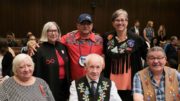(April 14, 2016) Earlier today the Supreme Court of Canada released its judgement in Daniels v Canada. Click the following link to view the judgement: http://scc-csc.lexum.com/scc-csc/scc-csc/en/item/15858/index.do
Métis Nation of Ontario (MNO) President Gary Lipinski stated: “This is a significant victory for the Métis Nation. It will facilitate reconciliation between Canada and Métis communities from Ontario westward.”
He added: “While this judgement removes the barriers that have stood in the way of reconciliation with the Métis it is critical that the federal government not delay and move quickly to the negotiating table with Métis governments.
“Currently Métis people do not receive access to whole series of programs and benefits that are available to First Nations and Inuit people. These include funding for postsecondary education, uninsured health benefits and many others. Exclusion from these programs has an impact on the daily lives of Métis people who are often the most impoverished of Indigenous peoples.”
President Lipinski also stressed the importance of establishing a land claims process for the Métis Nation.
“Starting negotiations immediately on land claims is essential to deal with the historic grievance of the Métis Nation. We can no longer be a landless people in our own country.”
The following are the key elements in the judgement:
Declaration #1
- A declaration that Métis and Non-Status Indians are within the term “Indians” in Section 91(24) is issued. (para. 58)
- The declaration has practical utility to end the “jurisdictional tug-of-war” (para. 15). The Court acknowledged that the current situation has left Métis and non-status Indian communities in a “jurisdictional wasteland” so an answer to the question is necessary (para. 13). An answer to the question will allow these groups to hold government “accountable for the inadequate status quo” and “guarantee both certainty and accountability” (para. 15)
- Section 91(24) is about the federal governments relationship with all of Canada’s Aboriginal peoples—this includes the Métis and Non-Status Indians (para. 49). Section 91(24) and s. 35 should be read together in order to advance reconciliation.
- Constitutional changes, apologies for historic wrongs and appreciation of Aboriginal peoples as partners in Confederation all indicate that reconciliation with all of Canada’s Aboriginal peoples is Parliaments goal (para 37).
- There is no doubt that the Métis are a distinct people (para. 42). No need to delineate between which mixed ancestry communities are Métis and which are non status—they are both “Indians” within s. 91(24) (para. 46) Whether a community is non-status Indian and Métis will be worked out on a case-by-case basis. (para. 47)
- Section 91(24) has a different purpose that s. 35. Section 91(24) is about the federal governments relationship with Canada’s Aboriginal peoples. Section 35 deals with the recognition and affirmation or rights and claims. (para. 49).
- The Court goes out of its way to note that Métis and Non-Status Indian inclusion in s. 91(24) does not mean that all provincial legislation with respect to these groups are ultra vires (i.e., outside of the authority of provincial legislatures). This means that the Alberta Métis Settlements legislation is not problematic or inconsistent with Métis inclusion in s. 91(24).
Declaration #2
- The Crown is in a fiduciary relationship with all Aboriginal peoples, including, the Métis and Non-Status Indians. Delgamuukw and MMF already recognize that this fiduciary relationship based on Indigenous pre-existence. As such, granting the third declaration would be redundant. (paras. 43, 53)
Declaration #3
- There is already a Crown duty to negotiate with Métis and Non-Status Indian communities recognized in law. Haida, Tsilquotin and Powley already recognize a context specific duty to negotiate when Aboriginal rights are engaged. As such, granting the third declaration would be redundant. (para 56)




Be the first to comment on "April 14 ruling marks a significant victory for the Metis Nation"